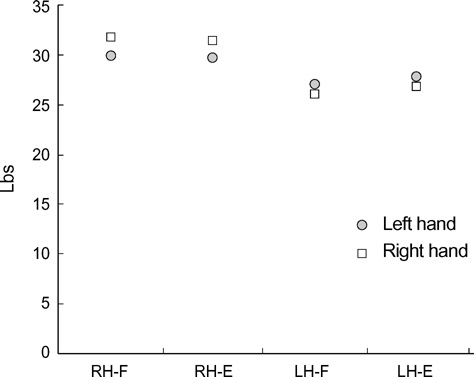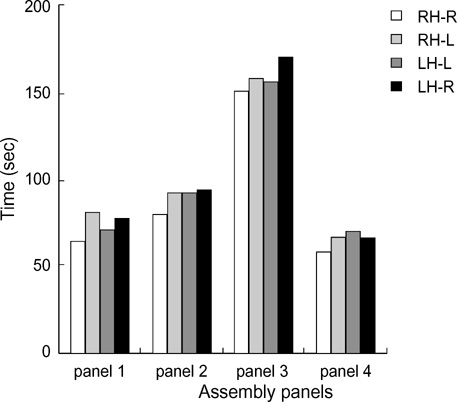J Korean Med Sci.
2004 Dec;19(6):874-878. 10.3346/jkms.2004.19.6.874.
Comparison of Pressure Pain Threshold, Grip Strength, Dexterity and Touch Pressure of Dominant and Non-Dominant Hands within and Between Right- and Left-Handed Subjects
- Affiliations
-
- 1Dokuz Eylul University School of Physical Therapy and Rehabilitation, Inciralti, 35340, Izmir-Turkey. ayse.ozcan@deu.edu.tr
- KMID: 1778572
- DOI: http://doi.org/10.3346/jkms.2004.19.6.874
Abstract
- This study was done to evaluate differences in pressure pain threshold, grip strength, manual dexterity and touch pressure threshold in the dominant and non-dominant hands of right- and left-handed subjects, and to compare findings within and between these groups. Thirty-nine right-handed and twenty-one left-handed subjects participated in the study. Pressure pain threshold was assessed using a dolorimeter, grip strength was assessed with a hand-grip dynamometer, manual dexterity was evaluated using the VALPAR Component Work Sample-4 system, and touch pressure threshold was determined using Semmes Weinstein monofilaments. Results for the dominant and non-dominant hands were compared within and between the groups. In the right-handed subjects, the dominant hand was significantly faster with the VALPAR Component Work Sample-4, showed significantly greater grip strength, and had a significantly higher pressure pain threshold than the non-dominant hand. The corresponding results for the two hands were similar in the left-handed subjects. The study revealed asymmetrical manual performance in grip strength, manual dexterity and pressure pain threshold in right-handed subjects, but no such asymme-tries in left-handed subjects.
Keyword
MeSH Terms
Figure
Reference
-
1. Desrosiers J, Hebert R, Bravo G, Rochette A. Age-related changes in upper extremity performance of elderly people: A longitudinal study. Exp Gerontol. 1999. 34:393–405.
Article2. Rondinelli RD, Dunn W, Hassanein KM, Keesling CA, Meredith SC, Schulz TL, Lawrence NJ. A simulation of hand impairments: effects on upper extremity function and implications toward medical impairment rating and disability determination. Arch Phys Med Rehabil. 1997. 78:1358–1363.
Article3. Francis KL, Spirduso WW. Age differences in the expression of manual asymmetry. Exp Aging Res. 2000. 26:169–180.4. Desrosiers J, Bravo G, Hebert R, Dutil E, Mercier L. Validation of the box and block test measure of dexterity of elderly people: reliability, validty, and norms studies. Arch Phys Med Rehab. 1994. 75:751–755.5. Desrosiers J, Bravo G, Hebert R, Mercier L. Impact of elbow position on grip strength of elderly men. J Hand Ther. 1995. 8:27–30.
Article6. Armstrong CA, Oldham JA. A Comparison of dominant and nondominant hand strengths. J Hand Surg. 1999. 24-B:421–425.
Article7. Hanten WP, Chen WY, Austin AA, Brooks RE, Carter HC, Law CA, Morgan MK, Sanders DJ, Swan CA, Vanderslice AL. Maximum grip strength in normal subjects from 20 to 64 years of age. J Hand Ther. 1999. 12:193–200.
Article8. Incel NA, Ceceli E, Durukan PB, Erdem HR, Yorgancloglu ZR. Grip strength: effect of hand dominance. Singapore Med J. 2002. 43:234–237.9. Nussbaum EL, Downes L. Reliability of clinical pressure-pain algometric measurements obtained on consecutive days. Phys Ther. 1998. 78:160–169.
Article10. Vatine JJ, Shapira SC, Magora F, Adler D, Magora A. Electronic pressure algometry of deep pain in healthy volunteers. Arch Phys Med Rehabil. 1993. 74:526–530.
Article11. Pauli P, Wiedemann G, Nickola M. Pressure pain thresholds asymmetry in left-and right-handers: association with behavioural measures of cerebral laterality. Eur J Pain. 1999. 3:151–156.12. Bell-Krotoski J, Weinstein S, Weinstein C. Testing sensibility, including touch-pressure, two-point discrimination, point localization and vibration. J Hand Ther. 1993. 6:114–123.
Article13. Bell-Krotoski J, Fess EE, Figarola JH, Hiltz D. Threshold detection and Semmes-Weinstein monofilaments. J Hand Ther. 1995. 8:155–162.
Article14. Hage JJ, van der Steen LP, de Groot PJ. Difference in sensibility between the dominant and non-dominant index finger as tested using the Semmes-Weinstein monofilaments pressure aesthesiometer. J Hand Surg. 1995. 20-A:227–229.15. Van Turnhout AA, Hage J, De Groot PJ, De Lange-De Klerk ES. Lack of difference in sensibility between the dominant and non-dominant hands as tested with Semmes-Weinstein monofilaments. J Hand Surg. 1997. 22-B:768–771.
Article16. Fess EE. The need for reliability and validity in hand assessment instruments. J Hand Surg. 1986. 11-A:621–623.
Article17. Callahan AD. Hunter JM, Schneider LH, Mackin EJ, Callahan AD, editors. Sensibility Testing: Clinical methods. Rehabilitation of the hand. 1990. 3rd ed. Mosby: St Louis;594–610.18. Ganong WF. Higher functions of the nervous system: Conditioned reflexes learning & related phenomena. Review of Medical Physiology. 1993. 16th ed. California: Lange Medical Publ;247–248.
- Full Text Links
- Actions
-
Cited
- CITED
-
- Close
- Share
- Similar articles
-
- Development of Predictive Model for Assessment of Grip Strength among Koreans: Data from 2014-2015 Korea National Health and Nutrition Examination Survey
- Analysis of Grip and Pinch Strength in Korean People
- Pressure Threshold, Grip and Pinch Strength in Female Telephone Operators
- The relationship between grip strength and radius bone mineral density in postmenopausal women
- Normative Data of Grip and Pinch Strength for Screening of Cumulative Trauma Disorders





